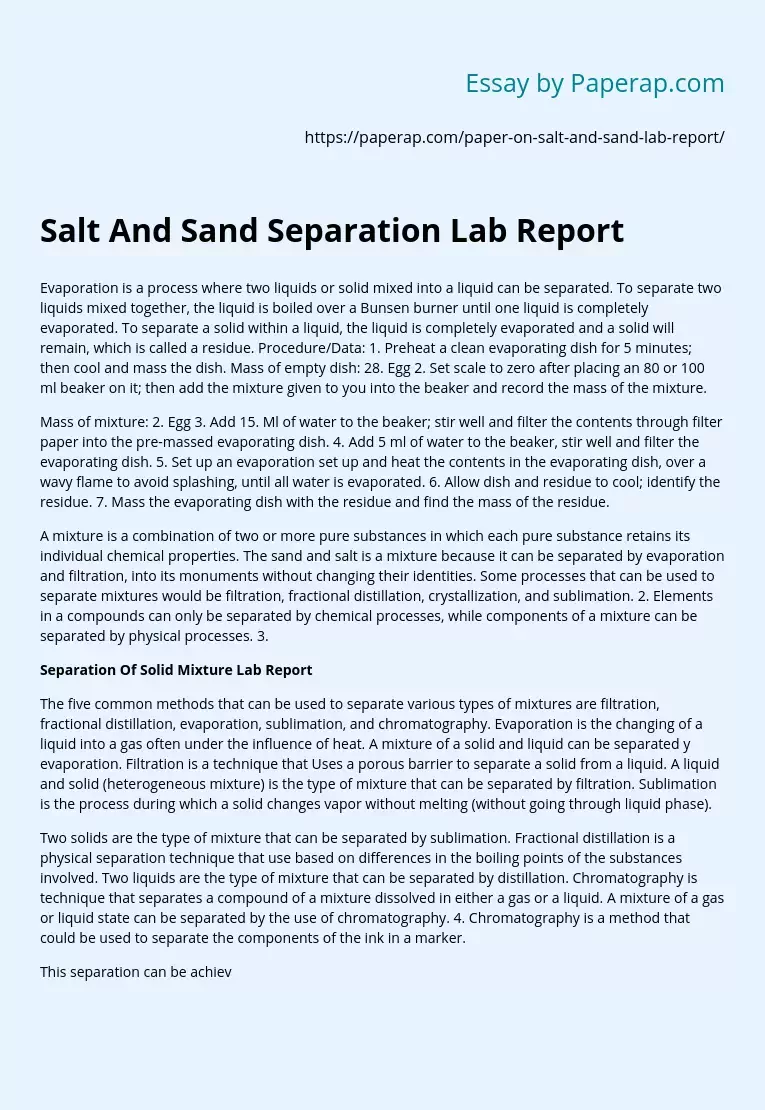Salt And Sand Separation Lab Report
Evaporation is a process where two liquids or solid mixed into a liquid can be separated. To separate two liquids mixed together, the liquid is boiled over a Bunsen burner until one liquid is completely evaporated. To separate a solid within a liquid, the liquid is completely evaporated and a solid will remain, which is called a residue. Procedure/Data: 1. Preheat a clean evaporating dish for 5 minutes; then cool and mass the dish. Mass of empty dish: 28. Egg 2. Set scale to zero after placing an 80 or 100 ml beaker on it; then add the mixture given to you into the beaker and record the mass of the mixture.
Mass of mixture: 2. Egg 3. Add 15. Ml of water to the beaker; stir well and filter the contents through filter paper into the pre-massed evaporating dish. 4. Add 5 ml of water to the beaker, stir well and filter the evaporating dish. 5. Set up an evaporation set up and heat the contents in the evaporating dish, over a wavy flame to avoid splashing, until all water is evaporated.
6. Allow dish and residue to cool; identify the residue. 7. Mass the evaporating dish with the residue and find the mass of the residue.
A mixture is a combination of two or more pure substances in which each pure substance retains its individual chemical properties. The sand and salt is a mixture because it can be separated by evaporation and filtration, into its monuments without changing their identities. Some processes that can be used to separate mixtures would be filtration, fractional distillation, crystallization, and sublimation.
2. Elements in a compounds can only be separated by chemical processes, while components of a mixture can be separated by physical processes. 3.
Separation Of Solid Mixture Lab Report
The five common methods that can be used to separate various types of mixtures are filtration, fractional distillation, evaporation, sublimation, and chromatography. Evaporation is the changing of a liquid into a gas often under the influence of heat. A mixture of a solid and liquid can be separated y evaporation. Filtration is a technique that Uses a porous barrier to separate a solid from a liquid. A liquid and solid (heterogeneous mixture) is the type of mixture that can be separated by filtration. Sublimation is the process during which a solid changes vapor without melting (without going through liquid phase).
Two solids are the type of mixture that can be separated by sublimation. Fractional distillation is a physical separation technique that use based on differences in the boiling points of the substances involved. Two liquids are the type of mixture that can be separated by distillation. Chromatography is technique that separates a compound of a mixture dissolved in either a gas or a liquid. A mixture of a gas or liquid state can be separated by the use of chromatography. 4. Chromatography is a method that could be used to separate the components of the ink in a marker.
This separation can be achieved when the pigment is dipped in a liquid and the different colors will behave differently, causing them to travel at different speeds. The ink separates because each pigment has a different attraction to the liquid. 5. To separate the heterogeneous mixture comprised of sand, iron fillings, salt, and poppy seeds the first thing that an be done is to use a magnet to attract the iron fillings from the mixture. Next, water should be added to not only dissolve the salt into the water but to cause the poppy seeds to float, making it easy to take them out.
Then mix the sand, salt and water together to make a mixture of salt and water. Now with sand and salt water left, filtrate the mixture to allow the salt water to pass through the filter paper and the sand will stay behind as residue. Finally, evaporation should be used to evaporate all the water from the mixture leaving salt behind as residue. 6. Filtrate is what passes through the filter paper when using filtration. The salt water was the filtrate in this lab. Residue is what is left behind, or is stayed back.
Salt And Sand Separation Lab Report. (2019, Dec 05). Retrieved from https://paperap.com/paper-on-salt-and-sand-lab-report/

